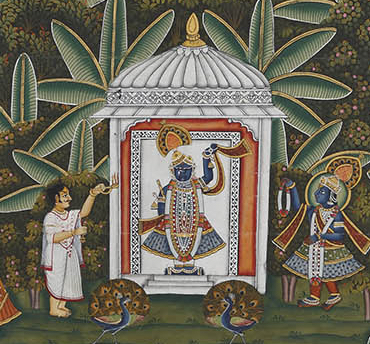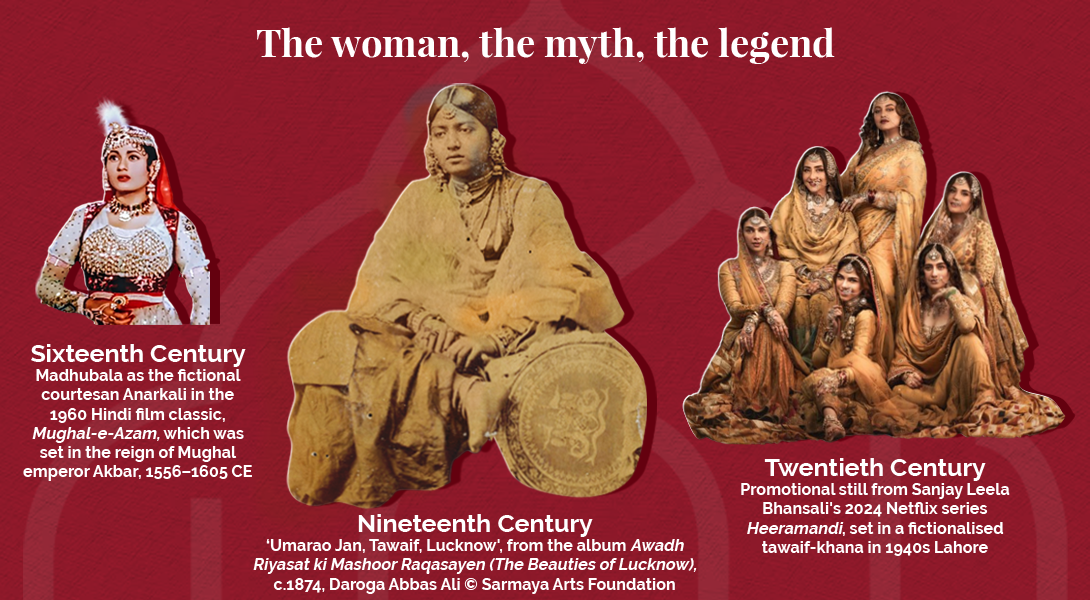
The courtesan has been a muse in many Indian cultures for centuries. Encounters between her, as an apsara, and the ascetic are the stuff of lore in Sanskrit literature. In art, too, she is everywhere. She plays cymbals on the walls of Ajanta; she’s among the revellers at Prince Dara Shukoh’s wedding; and she’s immortal on screen, stealing the scene in everything from Mughal-e-Azam (1960) to Heeramandi (2024).
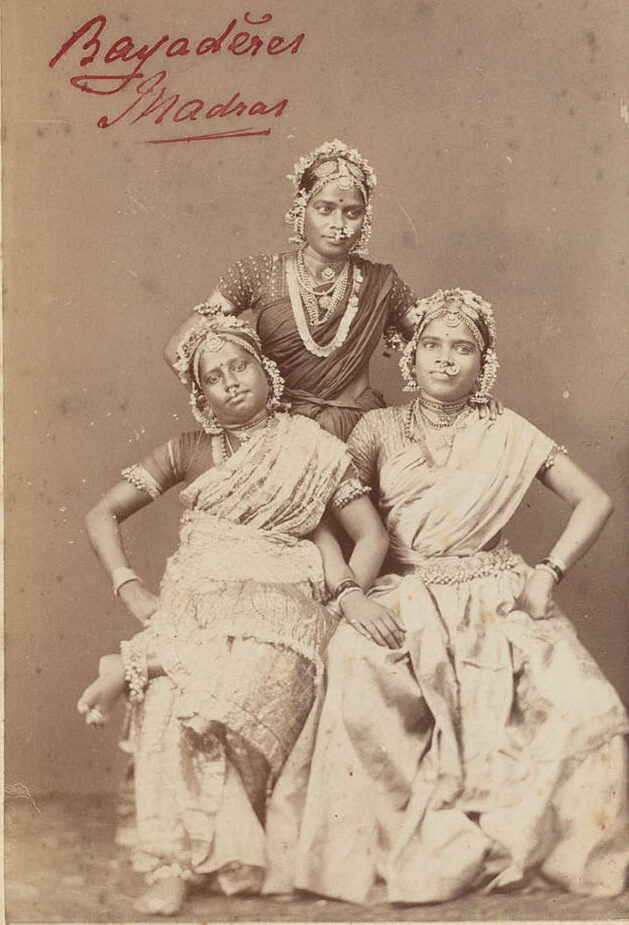
Bayaderes or Hindu temple dancers, Madras © Sarmaya Arts Foundation 2022.14.104 (b)
While the Indian courtesan shares some similarities with the geishas of Japan and the hetairai of ancient Athens, she is set apart by her association with the divine. Among the earliest literary references to her are the apsaras of Hindu epics, like Urvashi, Tillotama and Rambha, who were called forth to tempt sages and entertain royals. Amrapali, a courtesan from the time of Gautama Buddha, is believed to have gained mastery over Chatushashti Kalas, the 64 arts described in detail in the Kamasutra.
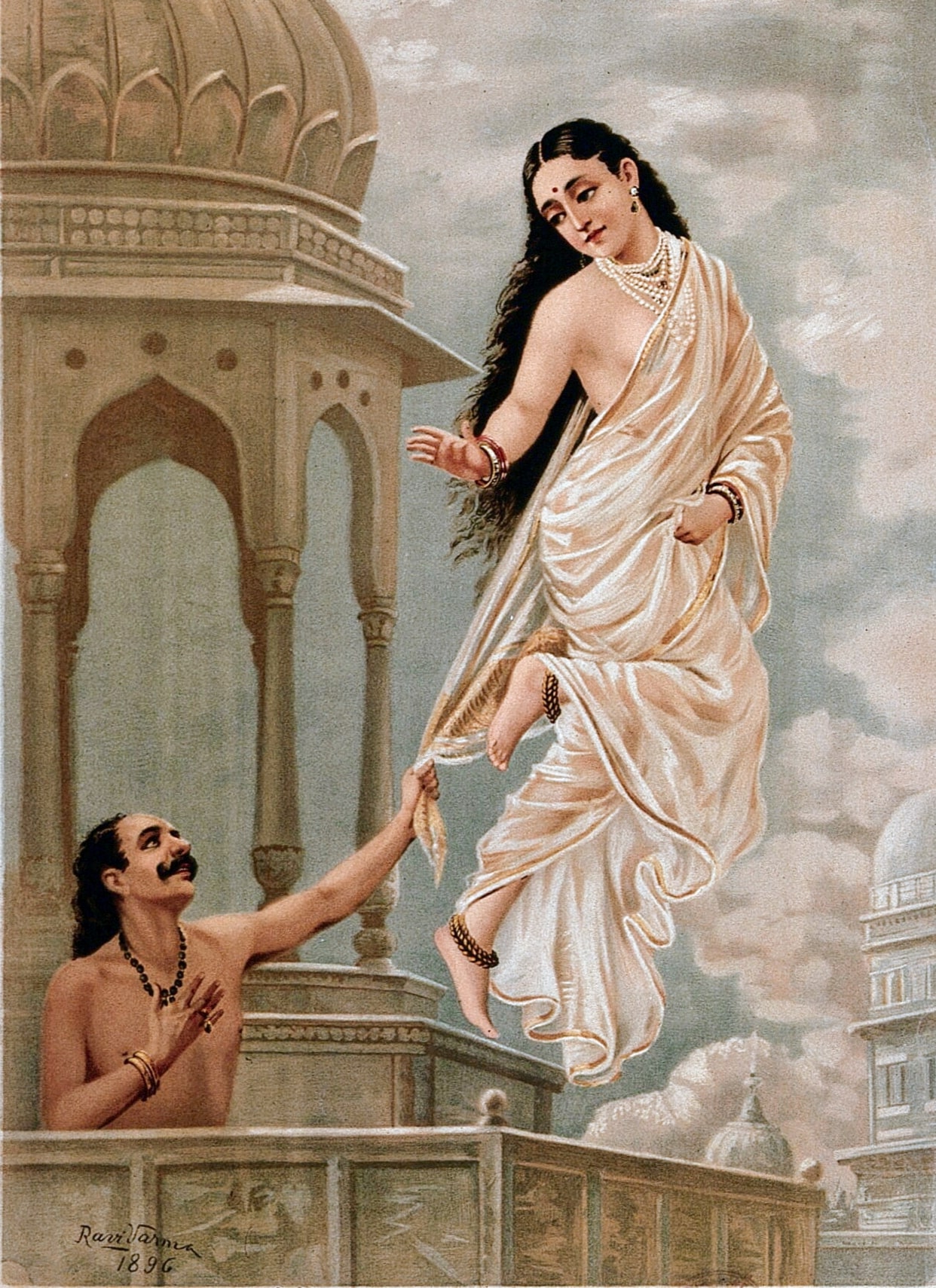
Urvashi, the apsara, leaving King Pururavas, 1896, chromolithograph, Raja Ravi Varma, Public Domain/Wikipedia Creative Commons
Madhur Gupta, author of the best-selling Courting Hindustan –The Consuming Passion Of Iconic Women Performers of India, observes, “In India, even our gods dance and sing, whether it’s Shiva, Krishna, Ganesh or Saraswati. So, our ethos is very wholesome. We are not a dry society; India has always had a rich inclination towards ‘bhog vilas’ [the sensual pleasures]. And courtesans were supremely crucial to this. In them resides the entire knowledge system of the finer things in life. So their role goes beyond entertainment.”
Save the dance
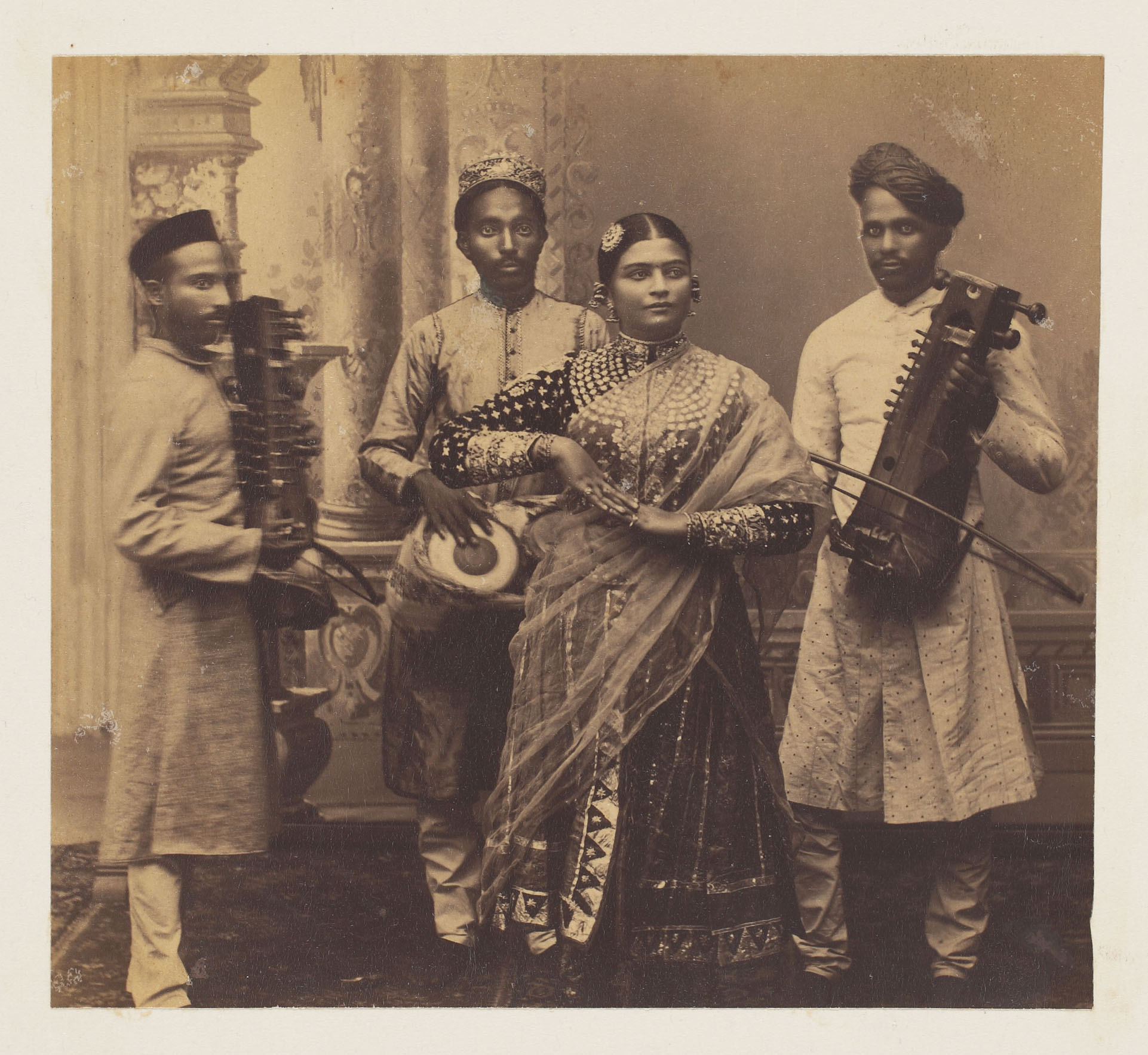
Dancer and Musicians, Royal Court of Jaisalmer, 1880-1890, Gobindram and Oodeyram, ⓒ Sarmaya Arts Foundation. 2018.52.7
Historically in India, courtesan-ship has taken different forms. In the Mughal culture, prominent in the North, tawaifs were courtesans to nobility. They were regarded as the high priestesses of art and the epitome of cultural sophistication. In the South, following the devadasi tradition, young girls would be given up by their families to serve at temples. Here, they would acquire all the arts of worship, like music and dance, and refine them to the highest degree. The devadasi tradition has different regional forms, which includes the muralis of Maharashtra, the maharis of Odisha, and the jogammas of Karnataka. A more secular label was nartaki. No matter what they were called or where they lived, these women contributed immensely to the preservation of Indian classical dance traditions, says Madhur Gupta, who is himself a respected Odissi dancer and the founder of Sangeet Vidya Niketan, a school of Indian classical dance and music in Delhi.
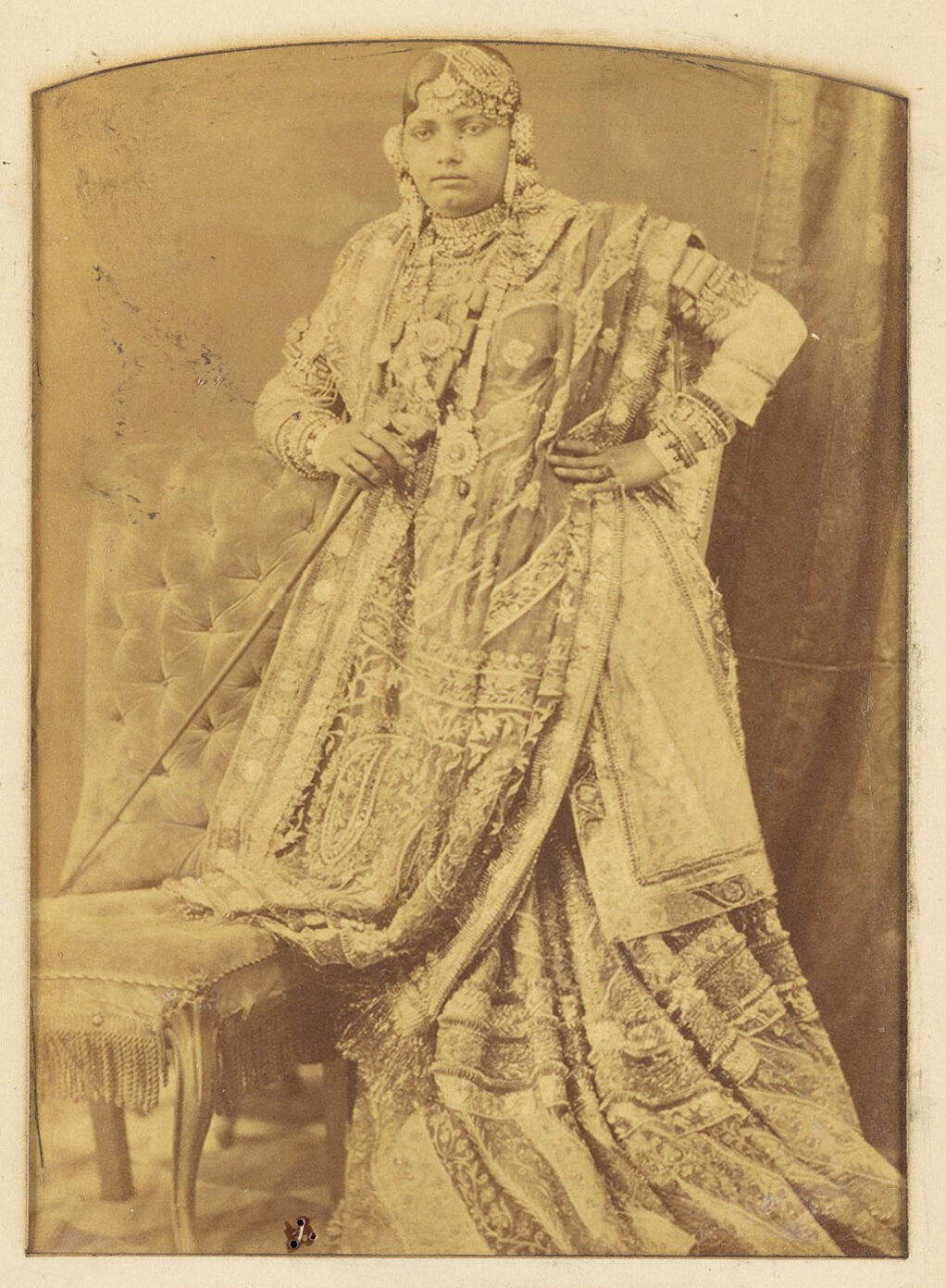
Gouhar, Lucknow Riyasat, from ‘Awadh Riyasat ki Mashoor Raqasayen’ (The Beauties of Lucknow), c.1874, Daroga Abbas Ali © Sarmaya Arts Foundation. 2022.5.1 (18)
“The word ‘classical’ in the Indian classical dance tradition refers to the revived art forms, from the late 1800s to the early 1900s,” says Gupta. “All the dances the courtesans did, whether it was in a kotha, salon or temple, were remodified and restructured, and titled ‘classical’. So, how did the courtesans provide input and impetus to the dance forms? By carrying on despite the social, economic and moral stigma they endured their entire lifetime. Through sheer grit and determination, they faced all the violations and harassments, and stood their ground. So, Indian dance, in its essence, has stayed relevant through 2,000 years because of these women entertainers.”
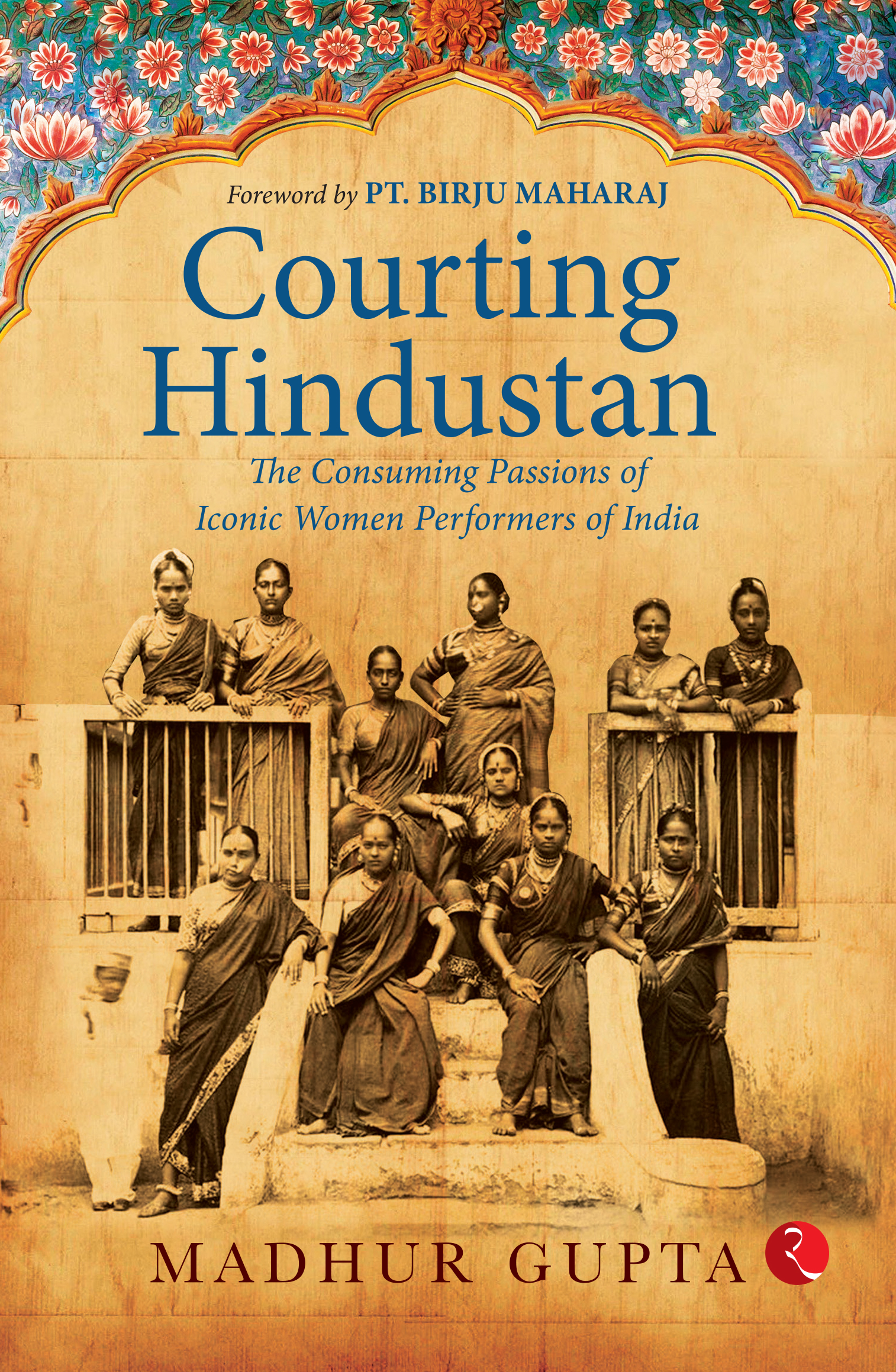 Courting Hindustan is the result of years of research uncovering the lesser-known stories of the more prominent of these personalities. They rose to become rulers (Begum Samru) and queens (Begum Hazrat Mahal). In the 20th century, women with courtesan origins presided over the airwaves (Gauhar Jaan, Janki Bai), the stage (Begum Akhtar), and the screen (Jaddan Bai). One of them, Tanjore Balasaraswati, was recognised with the title of Padma Vibhushan for being a pioneering legend of Bharatanatyam.
Courting Hindustan is the result of years of research uncovering the lesser-known stories of the more prominent of these personalities. They rose to become rulers (Begum Samru) and queens (Begum Hazrat Mahal). In the 20th century, women with courtesan origins presided over the airwaves (Gauhar Jaan, Janki Bai), the stage (Begum Akhtar), and the screen (Jaddan Bai). One of them, Tanjore Balasaraswati, was recognised with the title of Padma Vibhushan for being a pioneering legend of Bharatanatyam.
Spirit of the time

Untitled, 19th Century, ⓒ Sarmaya Arts Foundation. 2018.54.2
Nineteenth-century studio photographs of the courtesans reveal women with infinite style and rutba (distinction). Decked in softly glowing muslin and ornaments, with shining hair and Frida Kahlo-esque eyebrows, their gaze and stance, direct and proud. In Beauties of Lucknow, a photo album produced by Daroga Haji Abbas Ali in 1874, their skill in styling, layering and modelling Indian couture is abundantly evident. In his popular 1996 book Nautch Girls of India, scholar of history Pran Nevile wrote: Their dress was modesty itself, and nothing but their faces, feet and hands were exposed. Some wore ghagras and saris, others boleros and pyjamas held at the waist by a silk cord (zarband) studded with pearls. The odhani or dupatta, transparent and soft as the web of the gossamer spider, was the most graceful part of the costume. They made extravagant use of scents and perfumes, such as jasmine, frangipani, attar of roses, sandalwood and musk.
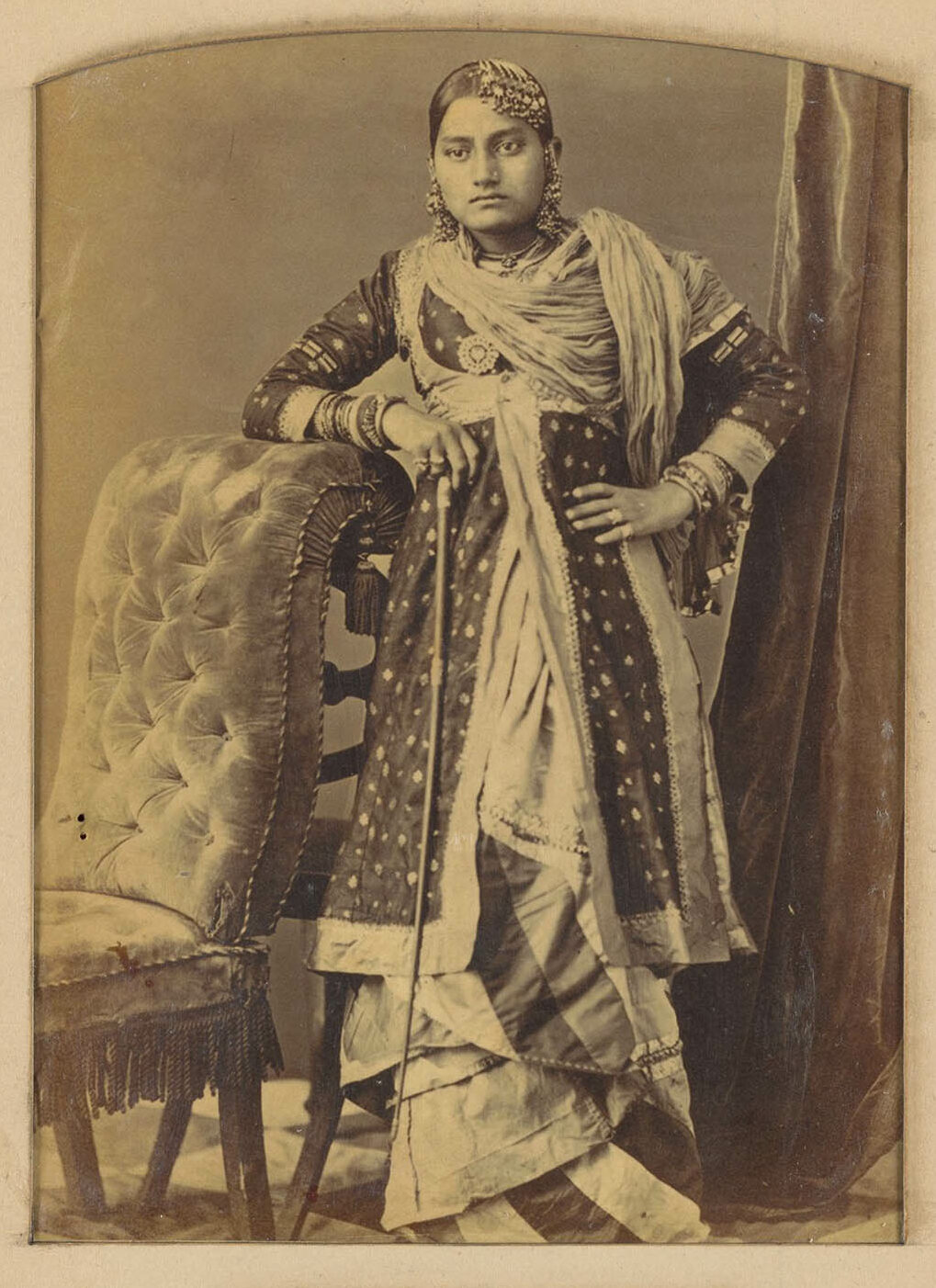
‘Abadee, Dancing girl, Awadh’, from ‘Awadh Riyasat ki Mashoor Raqasayen’ (The Beauties of Lucknow), c.1874, Daroga Abbas Ali © Sarmaya Arts Foundation. 2022.5.1 (7)
But the courtesan wasn’t just a consumer, she was a patron of indigenous Indian arts and crafts. Gupta says, “These women were the Madhuri and Sridevi of their time. They would not repeat their outfits more than once and be dripping with jewels. They were great connoisseurs and patrons of all Indian craftsmanship. When Begum Akhtar would face hardship, she would give her satlada haar (seven-string pearl necklace) to Arvind Parikh, a great patron of the arts, and borrow money against it. When she next earned money from her concerts, she would claim the necklace back. Balasaraswati wore the choicest of Kanjivarams, and they say, she would dazzle on stage. As very visible public personalities themselves, they became an intrinsic part of the system that sustained textiles and crafts.”
A class apart
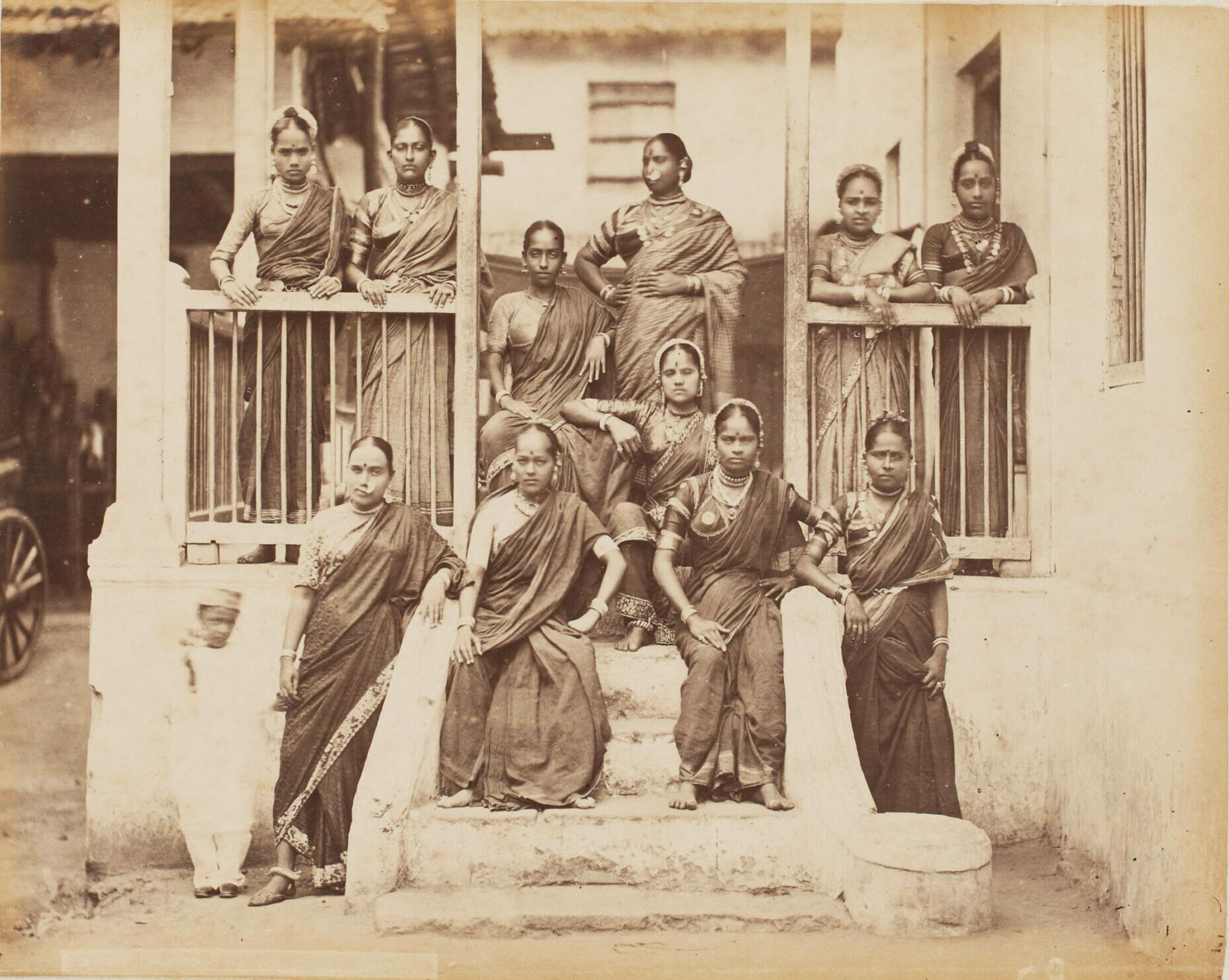
‘Group of Hindoo Nautch girls, Bombay’, Late-19th Century, albumen print ⓒ Sarmaya Arts Foundation. 2019.47.2 (33)
Part of the eternal allure of the courtesan is the fact that she was a rare phenomenon of her time: a single woman who was financially independent and had agency over her life choices. In Courting Hindustan, Gupta writes: The power and authority these women performers commanded [is glimpsed] from the civic tax records of 1858-77 in Lucknow: the tawaifs were the largest and highest tax-paying class.
“The courtesans in the late Mughal period were holders of great wealth,” says Gupta. “Till the 1900s, women, even of higher castes, could not own property in India; it would just go to the next-in-line male heir.” Courtesans were the exceptions to this rule, being allowed to even bequeath estates to their daughters.
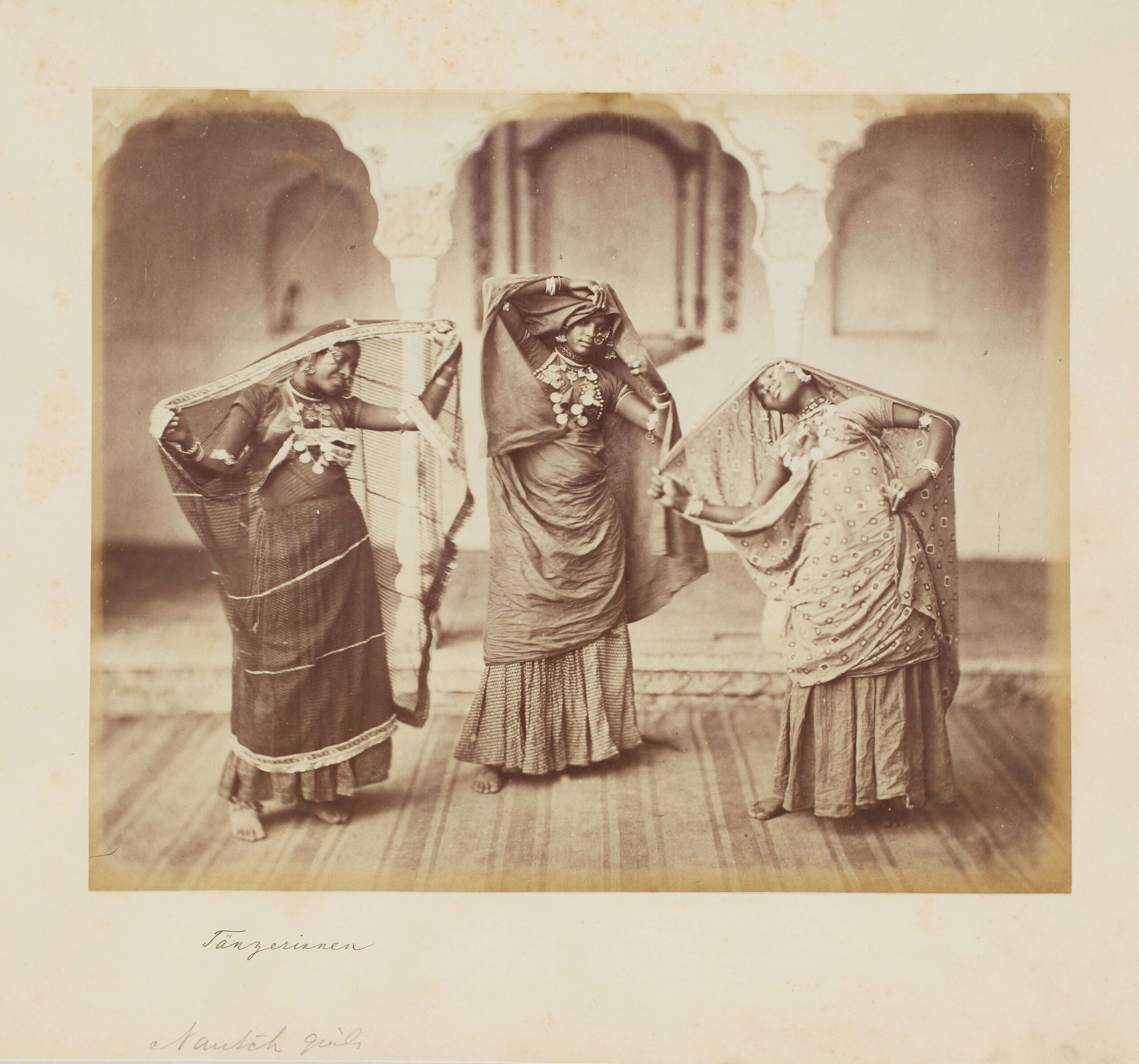
‘Nautch Girls, Delhi’, c.1862-1863, Charles Shepherd and Arthur Robertson, ⓒ Sarmaya Arts Foundation. 2017.67.26
“For two millennia, from Amrapali to Balasaraswati, courtesans owned their kothas or swapnakakshas (dream chambers),” says Gupta. “After the 1857 revolt, the British officers discovered the ITRs (income tax returns) of the courtesans in Lucknow. When they looted the nawab’s palace, all the jewellery, silk finery, silver spittoons, actually came from the zenana.”
For Gupta, this is the great irony of the Indian courtesan’s story. These influential women possessed and wielded considerable power in a patriarchal society for centuries. But they wouldn’t survive the ascendance of Victorian morality in the Subcontinent. Again, from Courting Hindustan: [By 1856]…intellectuals rejected courtesan culture as social debauchery, and devdasis were identified as an illegal mode of prostitution.
As we revisit their histories in 2024, through books like Madhur Gupta’s or Sanjay Leela Bhansali’s Netflix series Heeramandi on the tawaifs of 20th-century Lahore, we will hopefully see India’s courtesans for the ambitious, charismatic and visionary figures they were in real life.
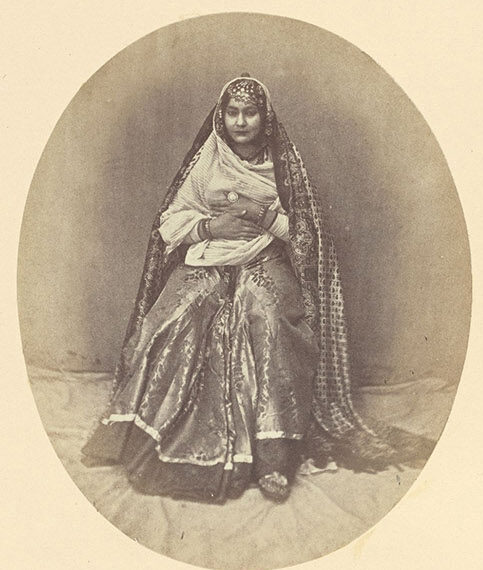
‘Zahore Begum, Mahomedan, Allahabad’, 1856-1863 © Sarmaya Arts Foundation. 2021.17.2 (49)
References
Nautch girls of India: Dancers, singers, playmates, 1996, Pran Nevile
Courting Hindustan –The Consuming Passion Of Iconic Women Performers of India, 2023, Madhur Gupta
The Representation of the Figure of the Devadasi in European Travel Writing and Art from 1770 to 1820, 2013, Claire Scobie



